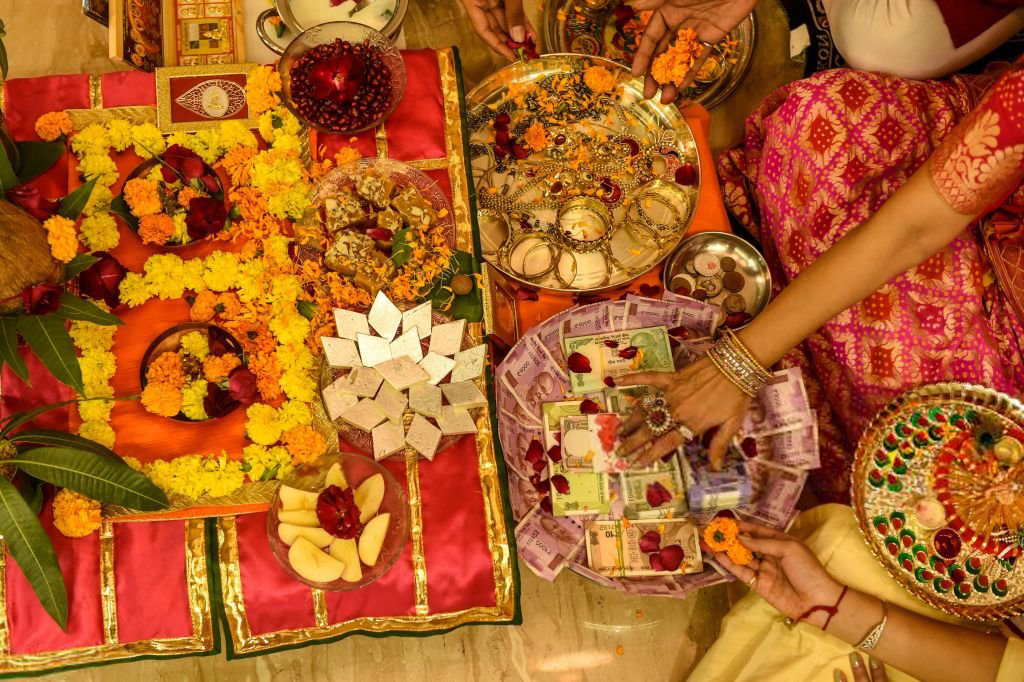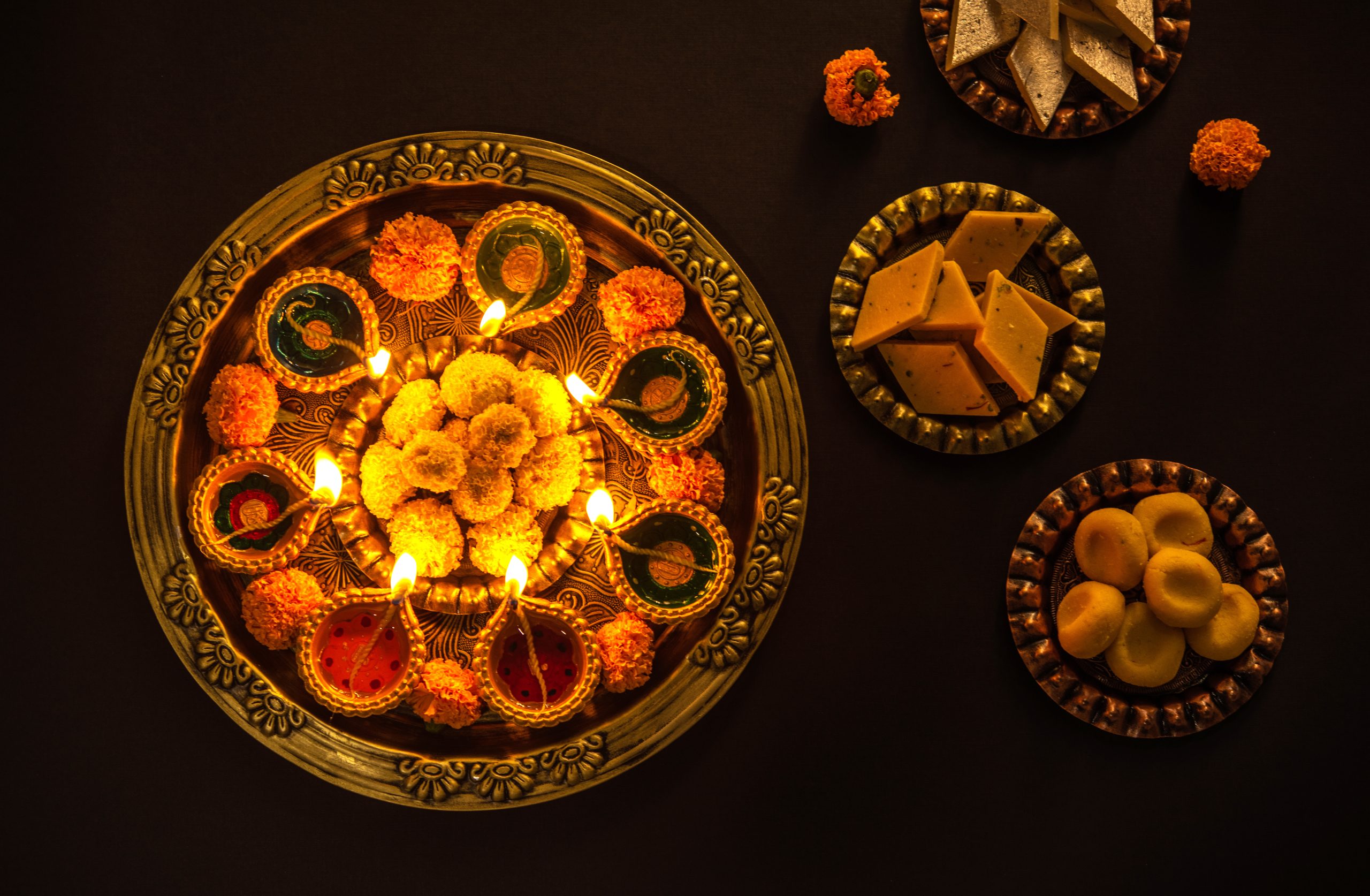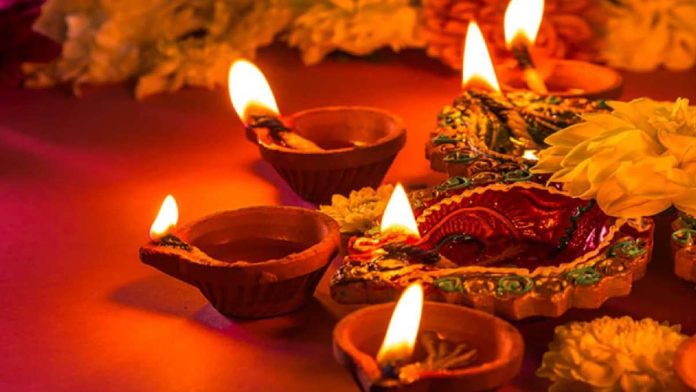Diwali or the Indian Festival of Lights is celebrated around the world over a period of five days during the Hindu lunisolar calendar month of Kartik, which usually occurs between mid-October and mid-November in the Gregorian calendar.
In the lead-up to Diwali, celebrants across India and among the diaspora worldwide engage in several traditional rituals and practices. In many places this is a time when every nook and cranny of a house gets a thorough makeover, renovations and refurbishing of homes also take place ahead of the festivities. Stacks of small earthen oil lamps, referred to as diyas are taken out of year-long storage and cleaned in preparation for lining them in front of houses and on terraces. Rangolis, or colorful designs and patterns are drawn on the floor at entrances to homes. The vibrant artwork is created using natural dyes made from rice flour, lentils, powdered bricks, chalk and flowers.
The two days prior to Diwali Day, the main Diwali day, and the two days following it, are of special significance, with each day of the festival having different religious connotations based on different regions of India and beliefs of people celebrating. On the main Diwali day, in the morning worshippers solemnly visit temples to offer prayers, don new clothes and people go visiting neighbors, friends and relatives. Greetings are exchanged, sweets and other delicacies are gifted, and delicious meals cooked for the occasion are shared by neighbors, friends and family.
All of the simple rituals of Diwali have a religious or social significance and a mythological tale behind them. Homes are illuminated with lights as a mark of respect and adoration of the gods, and fireworks fill the skies as an expression of thanks to the heavens for all the bounties of health, wealth, knowledge, peace, and prosperity granted to the people. Here is a look at some of the mythological significances and rituals performed over the five days of Diwali:

Dhanteras: In many regions, Dhanteras mark the start of Diwali. This day marks the birthday of Lakshmi — the Goddess of Wealth and Prosperity, and the birthday of Dhanvantari — the Goddess of Health and Healing. Diyas are lit and kept burning throughout the night in honor of Lakshmi and Dhanvantari. Dhanteras is also a major shopping day, particularly for gold or silver articles. A special Lakshmi Puja is performed in the evening.
Naraka chaturdasi: The second day of the Diwali festival is Naraka Chaturdasi marking the vanquishing of the demon Naraka by Lord Krishna and his wife Satyabhama. Homes are decorated with rangoli and women embellish their hands with henna designs. Families are also busy preparing homemade sweets for the main Diwali.
Diwali:The third day of the five-day festival is usually celebrated as the main festive day of Diwali. People don their new clothes, diyas are lit and special pujas are offered to the Goddess Lakshmi. Windows and doors are left open to provide easy access for the Goddess. After the puja, people go out and celebrate by bursting fire-crackers. Visits to friends and relatives and exchange of gifts and sweets also take place on this day.
In some places, additional deities, usually Ganesha, Saraswati, and Kubera are honored on this day with offerings and pujas. Blessings are invoked from Goddess Lakshmi as she symbolizes wealth and prosperity, while Lord Ganesha symbolizes ethical beginnings and is a fearless remover of obstacles. Meanwhile, Goddess Saraswati symbolizes music, literature and learning and Lord Kubera symbolizes bookkeeping, treasury and wealth management. Among some business communities, new account books for the year ahead are opened on this occasion
Padwa:The day after Diwali celebrates the love and mutual devotion between the wife and husband. The husbands give gifts to their wives on this day. In many regions, newly married daughters with their husbands are invited to parents’ home for special meals. Sometimes brothers go and pick up their sisters from their in-laws’ home for this important day. The day is also a special day for the married couple, in a manner similar to anniversaries elsewhere in the world. The day after Diwali devotees perform Govardhan puja in honor of Lord Krishna.
Bhai Dooj:The last day of the festival, called Bhai dooj, celebrates the strong relationship and bonds of love between sisters and brothers. The day ritually emphasizes the love and lifelong bond between siblings and is a day when women and girls get together, perform a puja with prayers for the well-being of their brothers and then get together with the rest of the family to share food.

In each legend, myth and story of Diwali lies the significance of the victory of good over evil. It is with each Diwali and with the lights that illuminate our homes and hearts, that the truth behind this simple message resonates and finds new reason and hope. From darkness unto light — the light that empowers us to commit ourselves to good deeds, that which brings us closer to divinity.
Mingled in the riot of lights, colors, sounds and odors that mark Diwali across the Indian subcontinent and around the world is a festival that symbolizes joy, togetherness and hope for the future.

















